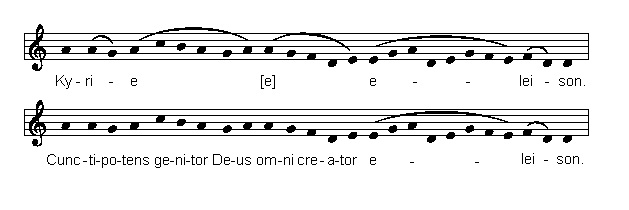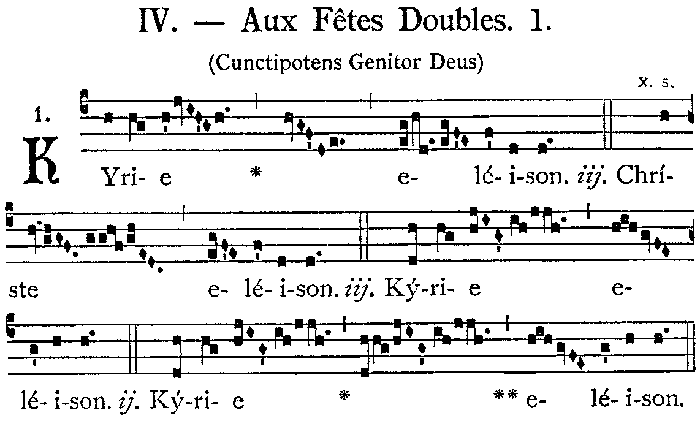Generally Kyries of the early medieval period contained long untexted portions. To compensate for this, Notker writes that he fitted Latin poetry to the untexted portions as a mnemotic device. Consequently, the Kyrie began to exist in two equally valid formats: the original Greek text and in a Latin prosula. In this case, prosula refers to the words added to the pre-existing chant. Such additions, known also as tropes were added to many chants, in both the Mass and the Office, that contained long melismatic passages. In the Mass this showed itself most clearly in the Kyrie and the Alleluia. Adding words, however, could become problematic, as tradition held that the words and music of the chants were given to the original composers by God himself. These added texts, nevertheless, served three purposes: to provide a memory aid for long melismas; to enhance and elaborate the liturgy; and (in a backhanded way) to create new liturgical texts. Tropes and Sequences (another form of medieval liturgical poetry) were severly restricted in the reforms of the 16th century Council of Trent: four Sequences were allowed to remain and all tropes were eliminated.
It is believed that a man named Tuotilo was responsible for writing this added text to Kyrie IV. Like Notker, Tuotilo was a monk at the monastery of St. Gall. Also like Notker, Tuotilo was a student of Iso annd Marcellus, unlike Notker, Tuotilo was also a sculptor and painter. Scholars believe that Notker and Tuotilo shared the work of composing prosulas; Notker was primarily responsible for adding text to the Alleluias and Tuotilo added text to other parts of the Mass. Ekkehard IV, who wrote a small biography of these early monks described Tuotilo's melodies as "strange and easily recognisable." Of Tuotilo himself, he wrote:
"Tutilo was widely different. [from Notker] He was strong and supple in arm and limb, such a man as Fabius tells us to choose for an athlete; ready of speech, clear of voice, a delicate carver and painter; musical, with especial skill on the harp and the flute; for the Abbot gave him a cell wherein he taught the harp to the sons of noble families around. He was a crafty messenger, to run far or near; skilled in building and all the kindred arts; he had a natural gift of ready and forcible expression whether in German or in Latin, in earnest or in jest; so that the emperor Charles [the Fat] once said, "Devil take the fellow who made so gifted a man into a monk!" But with all this he had higher gifts: in choir he was mighty, and in secret prayer he had the gift of tears; a most excellent composer of poetry and melodies, yet chaste, as became the disciple of our Master Marcellus, who shut his eyes against women."
The melody of this chant is exactly the same as that of Kyrie IV and as such shares the formal structure of the original. Both are Franco-Roman chants from the time of Charlemagne. Unlike most tropes which retain all the original words of the chant, Kyrie tropes tend to replace the word Kyrie with new text: thus the text here replaces "Kyrie" with "Cunctipotens genitor Deus omnes creator," thereby glossing the word "Kyrie" (God) with the attributes of "God": "All-powerful God creator of all things." The addition of the text changes the chant radically. What had once been a melismatic setting in which one text-syllable is stretched over a number of tones, becomes a syllabic setting in which each text syllable receives its own melody note. In many of these textual additions, the added text comments upon the original text.

A comparison of the opening of Kyrie IV and the Latin Kyrie Cunctipotens Genitor
Anonymous (Tuotilo?): Kyrie Cuntipotens Genitor (c. 900)
| Omnipotens genitor.... | 0:00 | Small group of soloists sing syllabic line of music (A) in unison. |
| Salvificet pietas .... | 0:18 | Small group repeats melody (A) with new words. |
| Fons et origo... | 0:34 | Third repeat of (A) with further new text. |
| Christe dei splendor... | 0:51 | Small group of soloists sing a different syllabic line of music (B) in unison. |
| Plasmatis humanis... | 1:05 | Small group repeats melody (B) with new words. |
| Ne tua dampnatur... | 1:19 | Third repeat of (B) with further new words. |
| Amborum sacrum spiramen... | 1:32 | Small group sings longer syllabic melody (C) in unison. Note the added length to the eleison. |
| Procedens fomes vite... | 1:47 | Small group sings repeat of melody (C) with new words. |
| Indultor culpe venie... | 1:59 | Small group sings modified version of (C). Note how the opening half of the phrase, the antecedent is repeated before moving on to the second half of the phrase, the consequent. |
| Spirite alme eleison | Omitted |
Translation
| Cunctipotens genitor Deus omnicreator eleison | All-powerful Father, God, Creator of all things, have mercy | |
| Salvificet pietas tua nos bone rector eleison | May thy compassion save us, good ruler, have mercy | |
| Fons et origo bone pie luxque perhennis eleison | Font and origin of goodness, Holy one, light everlasting, have mercy | |
| Christe dei splendor virtus patrisque sophia eleison | Christ, the splendor of God, strength and wisdom of the Father, have mercy | |
| Plasmatis humanis factor lapsis reparator eleison | Creator of humankind, healer of those who fall, have mercy | |
| Ne tua dampnatur Jhesu factura benigne eleison | Lest thy creation be damned, kind Jesus, have mercy | |
| Amborum sacrum spiramen nexus amorque eleison | The holy breath, the fusion and the love of both, have mercy | |
| Procedens fomes vite fons purificans vis eleison | Advancing flame, source of life, purifying power, have mercy | |
| Indultor culpe venie largitor optime offensas dele sacro nos munere reple eleison | Forgiver of sin, bestower of pardon, erase our offenses, replenish us, give us holy grace, have mercy | |
| Spirte alme eleison | Most gracious Spirit, have mercy |

The score as it looks in modern chant notation
To see other examples of early chant notation, click here.
All text © Todd Tarantino 2002-2012.
Not to be reprinted without permission.
www.toddtarantino.com
Contact